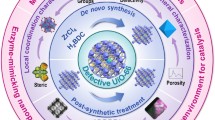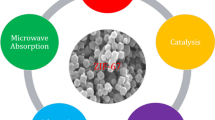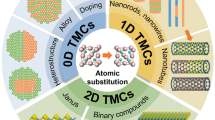Abstract
One-dimensional (1D) nanostructures of Co3O4 were synthesized via a mild hydrothermal route. The results of XRD, IR, and TEM revealed a phase transformation was accompanied by the replacement of NO3− with CO32− throughout the hydrothermal process. The symmetric types and amount of NO3− and CO32− intercalated between the brucite layers played an important role in the formation of nanowires from the hydrothermal system. The amount of CO32− increased as the hydrothermal reaction proceeded. The substitution of CO32− for NO3− led to a variation of interlayer forces thus resulted in the instability of intralayer interactions. Therefore, a shape transformation from sheets to wires occurred. Upon calcination, the shapes of precursors were preserved, and 1D nanostructures of Co3O4 resulted.
Similar content being viewed by others
Avoid common mistakes on your manuscript.
Introduction
The hydrothermal system simulating the mineral formation is adapted to synthesize one dimensional (1D) nanostructured materials with high crystallinity. 1D nanostructures of Co3O4 have aroused great interest due to its mixed valence states [1–3]. The 1D nanostructures could be achieved by many preparative strategies [4–8]. Co3O4 exhibited potential application in a wide variety of fields, such as battery materials [9–11], catalysis [12, 13], and magnetic materials [4, 8, 14]. It is now commonly known that the properties of nanomaterials strongly depend on the shape of particles, which is a dominating factor to their ultimate performance and applications [8, 15–18]. In this paper, a hydrothermal pathway was carried out to investigate the controlled formation of 1D Co3O4. The hydrothermal procedure was monitored combinationally by the techniques of XRD, TEM, and FT-IR in order to deeply understand the function of anions in the formation of 1D nanostructures.
Experimental
The typical preparation of 1D Co3O4 is described as follows: 5 × 10−3 mol Co(NO3)2·6H2O and 1.25 × 10−3 mol hexamethylenetetramine (HMT) were added into the 10 mL 5 × 10−3 mol/L sodium dodecylsulfate aqueous solution under ultrasonication. The solution was then transferred into the Teflon-lined stainless steel autoclave for hydrothermal treatment at 160°C for 6 h. The hydrothermally obtained anion-intercalated cobalt hydroxides were rinsed with deionized water and anhydrous alcohol three times and suffered calcination in air at 500°C for 6 h to produce the final products.
Thermogravimetric (TG) analysis and differential thermal analysis (DTA) were carried out in air for the precursor of Co3O4 with a Rigaku Thermplus TG8120 (Rigaku, Shibuya-ku, Japan) with a heating rate of 5°C/min. Powder X-ray diffraction (XRD) patterns of the samples were measured using a Rigaku γA Mini diffractometer with Cu Kα radiation (λ = 0.154178 nm). The morphologies were observed by transmission electron microscopy (TEM) (obtained using a JEM-100CXII electron microscope (JEOL, Akishima-shi, Japan)) and scanning electron microscopy (SEM) (carried out by JSM-6700F). Fourier transform infrared spectra (FT-IR) of samples formed in KBr platelets were recorded with an Avatar 370 FT-IR spectrometer (ThermoNicolet, Waltham, MA, USA) in the range of 400 to 4000/cm to investigate the crystalline form of products.
Findings
The TGA-DTA analysis for precursors suggests two steps of losing weight: the weight loss below 100°C is mainly due to dehydration of physically absorbed water, while the decomposition of NO3− and CO32− ions, together with the dehydration of OH groups between brucite layers of Co(OH)2 during which occurs a simultaneous conversion into spinel Co3O4, contribute to the greater weight loss observed between 200°C and 500°C. Correspondingly, two endothermic peaks are shown in the DTA curve. The precursors have transformed completely into Co3O4 above 500°C (Figure 1).
The precondition to obtain the 1D nanostructures of Co3O4 is synthesizing the 1D precursor. The molar ratio of starting reactants was found as an important parameter; therefore, some experiments were carried out by varying both Co(NO3)2 and HMT amounts. Only within a very narrow range of the molar ratio of [Co2+] to [(CH2)6N4] (2:1 ~ 4:1), the wirelike precursors of cobalt basic nitrate carbonate could be obtained. The precursors and final products calcined at 500°C were further characterized by TEM and SEM techniques. A typical TEM image of Figure 2a reveals that the precursors display almost perfect 1D morphologies with widths about 100 nm. The lengths are estimated about 3 to 10 μm. Apparently, the aspect ratios of these 1D nanostructures are notably large. In addition, the precursors have proved the copiousness in quantity, and the uniformity in size distribution. The calcined products exhibit rough surfaces, as shown in Figure 2b, c, suggesting the polycrystalline feature. The energy dispersive spectrum (EDS) of the selected field, which is white framed in Figure 2c, was measured for the 500°C-calcined products, and the result displayed in Figure 2d indicates the molar ratio of Co/O equal to 0.72, in good agreement with the theoretic value of Co3O4.
As shown in Figure 3, XRD, TEM, and IR techniques were employed combinationally in order to gain some insights on the function of anions in the formation of 1D Co3O4.
Reaction time dependence of XRD patterns for precursors exhibited a phase transformation from initial metastable α-Co(OH)2 to the thermodynamically stable phase, which showed a similarity with Co(CO3)0.35Cl0.2(OH)1.1·0.74H2O, implying that NO3− ions occupied the same position as Cl− ions in the NO3− intercalated cobalt carbonate hydroxide.
The phase transformations were accompanied by the morphology alterations. As shown in Figure 3, nanosheets were obtained after 20 min of hydrothermal treatment. When the holding time was prolonged to 1 h, 1D nanostructures with the length of 2 μm coexisted with the nanosheets. After the holding time increased above 2 h, only nanowires were obtained.
FT-IR technique is an effective way to investigate the kind of anions intercalated between the Co(OH)2 layers. The precursor α-Co(OH)2 taken from solution at 20 min has a large interlayer space, designated literally as a pre-hydrotalcite-like phase as confirmed by IR and XRD. Water bending mode is also found at 1,601/cm, about 30/cm red shift due to strong interactions with the interlayer anions of NO3− and/or CO32−. In agreement with the structural assignment, absorption peaks at 1,384 and 839/cm (ν3 and ν2 vibration modes of NO3− with D3h symmetry) indicate that a large number of NO3− anions are included [19, 20]. With increasing the holding time, the intensity of the peak at 1,384/cm decreased obviously, and the ν2 vibrational modes appear at 830/cm, apparently lower than NO3− with D3h symmetry, indicating an increment in the perturbation of the intercalated NO3−. Simultaneously, two peaks appear at 1,480 and 1,312/cm, which can be assigned to symmetric vibrational mode (νs(ONO2)) and asymmetric vibrations (νas(ONO2))on monodentate nitrate, respectively. In addition, the appearance of a tiny peak at 1,312/cm suggests that the amount of NO3− is significantly reduced [19, 21]. The IR spectra for sample prepared after the holding time above 2 h shows two more absorptions at 1,506 and 1,035/cm, which belong to the ν3 and ν1 vibrational modes of carbonate anions with C2V symmetry. Compared with the data from Xu and Zeng [20], the two absorptions exhibited blue and red shifts, respectively. The perturbation can be attributed to stronger electrostatic interactions between the divalent CO32− anions and the brucite-like sheets.
In summary, the probable procedure for the formation of 1D Co3O4 could be described as follows: initially, a large amount of NO3− ions intercalated between the brucite layers, adopting D3h symmetry. The amount of CO32− gradually produced by hydrolysis and oxidation of HMT increased, leading to the substitution for some of NO3− ions and the alteration of symmetry from D3h to C2v. Consequently, the modification of interlayer forces resulted in the instability of intralayer interactions, and the two-dimensional nanosheets eventually transformed to 1D nanostructures. The morphology was preserved in calcination to produce 1D Co3O4.
References
Lakshmi BB, Patrissi CJ, Martin CR: Sol-gel template synthesis of semiconductor oxide micro-and nanostructures. Chem. Mater. 1997, 9: 2544–2550. 10.1021/cm970268y
Liu Y, Wang G, Xu C, et al.: Fabrication of Co 3 O 4 nanorods by calcination of precursor powders prepared in a novel inverse microemulsion. Chem. Commun. 2002, 1486–1487.
Wang D, Caruso RA, Caruso F: Synthesis of macroporous titania and inorganic composite materials from coated colloidal spheres - A novel route to tune pore morphology. Chem. Mater. 2001, 13: 364–371. 10.1021/cm001184j
Meher SK, Rao GR: Ultra-layered Co 3 O 4 for high performance supercapacitor applications. J. Phys. Chem. C 2011, 115: 25543–25556. 10.1021/jp209165v
Wei C, Nan Z: Effects of experimental conditions on one-dimensional single-crystal nanostructure of β-FeOOH. Mater. Chem. Phys. 2011, 127: 220–226. 10.1016/j.matchemphys.2011.01.062
Chen N, Huang C, Yang W, et al.: Growth control for architecture molecular conductor of low dimension nanostructures. J. Phys. Chem. C 2010, 114: 12982–12986. 10.1021/jp103911x
Kar S, Pal BN, Chaudhuri S, et al.: One-Dimensional ZnO nanostructure arrays: Synthesis and characterization. J. Phys. Chem. B 2006, 110: 4605–4611. 10.1021/jp056673r
Wang G, Shen X, Horvat J, et al.: Hydrothermal synthesis and optical, magnetic, and supercapacitance properties of nanoporous cobalt oxide nanorods. J. Phys. Chem. C 2009, 113: 4357–4361. 10.1021/jp8106149
Wang B, Wang Y, Park J, et al.: In situ synthesis of Co 3 O 4 /graphene nanocomposite material for lithium-ion batteries and supercapacitors with high capacity and supercapacitance. J. Alloys Compd. 2011, 509: 7778–7783. 10.1016/j.jallcom.2011.04.152
Yao X, Xin X, Zhang Y, et al.: Co 3 O 4 nanowires as high capacity anode materials for lithium ion batteries. J. Alloys Compd. 2012, 521: 95–100.
Li L, Wang Y, Wang Y, et al.: Mesoporous nano-Co 3 O 4 : A potential negative electrode material for alkaline secondary battery. J. Power. Sources 2011, 196: 10758–10761. 10.1016/j.jpowsour.2011.08.086
Cui Y, Wen Z, Sun S, et al.: Mesoporous Co 3 O 4 with different porosities as catalysts for the lithium–oxygen cell. Solid State Ionics. Solid State Ion. 2012, 225: 598–603.
Asano K, Ohnishi C, Iwamoto S, et al.: Potassium-doped Co 3 O 4 catalyst for direct decomposition of N 2 O. Appl. Catal. B 2008, 78: 242–249. 10.1016/j.apcatb.2007.09.016
Nethravathi C, Sen S, Ravishankar N, et al.: Ferrimagnetic nanogranular Co 3 O 4 through solvothermal Decomposition of colloidally dispersed monolayers of α-cobalt hydroxide. J. Phys. Chem. B 2005, 109: 11468–11472. 10.1021/jp050725v
Geng B, Zhan F, Fang C, et al.: A facile coordination compound precursor route to controlled synthesis of Co 3 O 4 nanostructures and their room-temperature gas sensing properties. J. Mater. Chem. 2008, 18: 4977–4984. 10.1039/b805378b
Jia Z, Wang Q, Ren D, et al.: Fabrication of one-dimensional mesoporous α-Fe 2 O 3 nanostructure via self-sacrificial template and its enhanced Cr(VI) adsorption capacity. Appl. Surf. Sci. 2013, 264: 255–260.
Luo Z, Yin S, Wang K, et al.: Synthesis of one-dimensional β-Ni(OH) 2 nanostructure and their application as nonenzymatic glucose sensors. Mater. Chem. Phys. 2012, 132: 387–394. 10.1016/j.matchemphys.2011.11.041
Song Q, John Zhang Z: Shape control and associated magnetic properties of spinel cobalt ferrite nanocrystals. J. Am. Chem. Soc. 2004, 126: 6164–6168. 10.1021/ja049931r
Xu ZP, Zeng HC: Interconversion of brucite-like and hydrotalcite-like phases in cobalt hydroxide compounds. Chem. Mater. 1999, 11: 67–74. 10.1021/cm980420b
Xu ZP, Zeng HC: Thermal evolution of cobalt hydroxides: a comparative study of their various structural phases. J. Mater. Chem. 1998, 8: 2499–2506. 10.1039/a804767g
Schraml-Marth M, Wokaun A, Baikert A: Surface structure of crystalline and amorphous chromia catalysts for the selective catalytic reduction of nitric oxide IV. Diffuse reflectance FTIR study of NO adsorption and reaction. J. Catal. 1992, 138: 306–321. 10.1016/0021-9517(92)90025-D
Author information
Authors and Affiliations
Corresponding author
Additional information
Competing interests
The authors declare that they have no competing interests.
Authors’ contributions
WMZ, as the corresponding author, instructed the other two authors to carry out the experiments and drafted the manuscript. MC synthesized the samples and contributed a lot in phase analysis of samples using techniques of XRD and TEM. YQJ provided his contributions in the IR analysis. All authors read and approved the final manuscript.
Authors’ original submitted files for images
Below are the links to the authors’ original submitted files for images.
Rights and permissions
Open Access This article is distributed under the terms of the Creative Commons Attribution 2.0 International License (https://creativecommons.org/licenses/by/2.0), which permits unrestricted use, distribution, and reproduction in any medium, provided the original work is properly cited.
About this article
Cite this article
Zhang, WM., Chen, M. & Jiang, YQ. Morphology dependence on anions in hydrothermal synthesis of Co3O4. Int Nano Lett 3, 44 (2013). https://doi.org/10.1186/2228-5326-3-44
Received:
Accepted:
Published:
DOI: https://doi.org/10.1186/2228-5326-3-44







